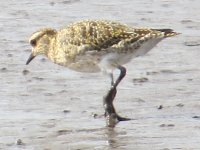Nutcracker
Stop Brexit!
I was watching a Redshank today, standing as they so often do, on one leg; the usual explanation for this being to save energy. It was in a small but steep-sided gully in a mudflat, with the rising tide nearly reaching it.
When the tide did reach it, instead of putting its other leg down to walk out easily, it hopped up the gully side on its single exposed leg, and had to flap its wings vigorously several times to keep balance on the mud.
That surely uses more energy than putting the 2nd leg down and walking? What is it that so strongly favours its staying on just one leg, even when it is awkward for it to do so?
When the tide did reach it, instead of putting its other leg down to walk out easily, it hopped up the gully side on its single exposed leg, and had to flap its wings vigorously several times to keep balance on the mud.
That surely uses more energy than putting the 2nd leg down and walking? What is it that so strongly favours its staying on just one leg, even when it is awkward for it to do so?






